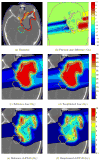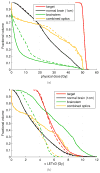Reoptimization of Intensity Modulated Proton Therapy Plans Based on Linear Energy Transfer
- PMID: 27869082
- PMCID: PMC5133459
- DOI: 10.1016/j.ijrobp.2016.08.038
Reoptimization of Intensity Modulated Proton Therapy Plans Based on Linear Energy Transfer
Abstract
Purpose: We describe a treatment plan optimization method for intensity modulated proton therapy (IMPT) that avoids high values of linear energy transfer (LET) in critical structures located within or near the target volume while limiting degradation of the best possible physical dose distribution.
Methods and materials: To allow fast optimization based on dose and LET, a GPU-based Monte Carlo code was extended to provide dose-averaged LET in addition to dose for all pencil beams. After optimizing an initial IMPT plan based on physical dose, a prioritized optimization scheme is used to modify the LET distribution while constraining the physical dose objectives to values close to the initial plan. The LET optimization step is performed based on objective functions evaluated for the product of LET and physical dose (LET×D). To first approximation, LET×D represents a measure of the additional biological dose that is caused by high LET.
Results: The method is effective for treatments where serial critical structures with maximum dose constraints are located within or near the target. We report on 5 patients with intracranial tumors (high-grade meningiomas, base-of-skull chordomas, ependymomas) in whom the target volume overlaps with the brainstem and optic structures. In all cases, high LET×D in critical structures could be avoided while minimally compromising physical dose planning objectives.
Conclusion: LET-based reoptimization of IMPT plans represents a pragmatic approach to bridge the gap between purely physical dose-based and relative biological effectiveness (RBE)-based planning. The method makes IMPT treatments safer by mitigating a potentially increased risk of side effects resulting from elevated RBE of proton beams near the end of range.
Copyright © 2016 Elsevier Inc. All rights reserved.
Conflict of interest statement
None
Figures





References
-
- Paganetti H. Relative biological effectiveness (RBE) values for proton beam therapy: Variations as a function of biological endpoint, dose, and linear energy transfer. Phys Med Biol. 2014;59:R419–R472. - PubMed
-
- Wilkens JJ, Oelfke U. Optimization of radiobiological effects in intensity modulated proton therapy. Medical Physics. 2005;32(2):455–465. - PubMed
-
- Frese MC, Wilkens JJ, Huber P, et al. Application of constant vs. variable relative biological effectiveness in treatment planning of intensity-modulated proton therapy. International Journal of Radiation Oncology Biology Physics. 2011;79(1):80–88. - PubMed
-
- Tseung HSWC, Ma J, Kreofsky CR, et al. Clinically-applicable Monte Carlo-based biological dose optimization for the treatment of head and neck cancers with spot-scanning proton therapy. International Journal of Radiation Oncology Biology Physics. 2016 in press. - PubMed
-
- Fager M, Toma-Dasu I, Kirk M, et al. Linear energy transfer painting with proton therapy: A means of reducing radiation doses with equivalent clinical effectiveness. International Journal of Radiation Oncology Biology Physics. 2015;91(5):1057–1064. - PubMed
Publication types
MeSH terms
Grants and funding
LinkOut - more resources
Full Text Sources
Other Literature Sources
Medical
Miscellaneous

